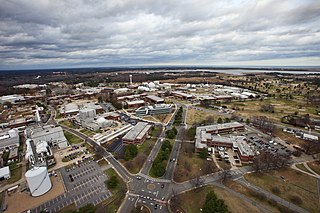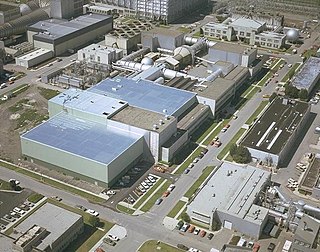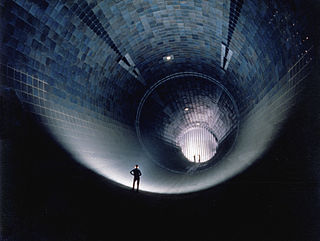Related Research Articles

Wind tunnels are machines where an object is held stationary inside a tube, and air is blown around it to study the interaction between the object and the moving air. They are used to test the aerodynamic effects of aircraft, rockets, cars, and buildings. Different wind tunnels range in size from less than a foot across, to over 100 feet (30 m), and can have air that moves at speeds from a light breeze to hypersonic velocities.

The National Advisory Committee for Aeronautics (NACA) was a United States federal agency founded on March 3, 1915, to undertake, promote, and institutionalize aeronautical research. On October 1, 1958, the agency was dissolved and its assets and personnel were transferred to the newly created National Aeronautics and Space Administration (NASA). NACA is an initialism, i.e., pronounced as individual letters, rather than as a whole word.

A scramjet is a variant of a ramjet airbreathing jet engine in which combustion takes place in supersonic airflow. As in ramjets, a scramjet relies on high vehicle speed to compress the incoming air forcefully before combustion, but where as a ramjet decelerates the air to subsonic velocities before combustion using shock cones, a scramjet has no shock cone and slows the airflow using shockwaves produced by its ignition source in place of a shock cone. This allows the scramjet to operate efficiently at extremely high speeds.

Richard Travis Whitcomb was an American aeronautical engineer who was noted for his contributions to the science of aerodynamics.

The Langley Research Center, located in Hampton, Virginia near the Chesapeake Bay front of Langley Air Force Base, is the oldest of NASA's field centers. LaRC has focused primarily on aeronautical research but has also tested space hardware such as the Apollo Lunar Module. In addition, many of the earliest high-profile space missions were planned and designed on-site. Langley was also considered a potential site for NASA's Manned Spacecraft Center prior to the eventual selection of Houston, Texas.

The Office national d'études et de recherches aérospatiales (ONERA) is the French national aerospace research centre. It is a public establishment with industrial and commercial operations, and carries out application-oriented research to support enhanced innovation and competitiveness in the aerospace and defense sectors.

Robert T. Jones,, was an American aerodynamicist and aeronautical engineer for NACA and later NASA. He was known at NASA as "one of the premier aeronautical engineers of the twentieth century".

A hypersonic wind tunnel is designed to generate a hypersonic flow field in the working section, thus simulating the typical flow features of this flow regime - including compression shocks and pronounced boundary layer effects, entropy layer and viscous interaction zones and most importantly high total temperatures of the flow. The speed of these tunnels vary from Mach 5 to 15. The power requirement of a wind tunnel increases linearly with its cross section and flow density, but cubically with the test velocity required. Hence installation of a continuous, closed circuit wind tunnel remains a costly affair. The first continuous Mach 7-10 wind tunnel with 1x1 m test section was planned at Kochel am See, Germany during WW II and finally put into operation as 'Tunnel A' in the late 1950s at AEDC Tullahoma, TN, USA for an installed power of 57 MW. In view of these high facility demands, also intermittently operated experimental facilities like blow-down wind tunnels are designed and installed to simulate the hypersonic flow. A hypersonic wind tunnel comprises in flow direction the main components: heater/cooler arrangements, dryer, convergent/divergent nozzle, test section, second throat and diffuser. A blow-down wind tunnel has a low vacuum reservoir at the back end, while a continuously operated, closed circuit wind tunnel has a high power compressor installation instead. Since the temperature drops with the expanding flow, the air inside the test section has the chance of becoming liquefied. For that reason, preheating is particularly critical.

The Boeing X-51 Waverider is an unmanned research scramjet experimental aircraft for hypersonic flight at Mach 5 and an altitude of 70,000 feet (21,000 m). The aircraft was designated X-51 in 2005. It completed its first powered hypersonic flight on 26 May 2010. After two unsuccessful test flights, the X-51 completed a flight of over six minutes and reached speeds of over Mach 5 for 210 seconds on 1 May 2013 for the longest duration powered hypersonic flight.
Scramjet programs refers to research and testing programs for the development of supersonic combustion ramjets, known as scramjets. This list provides a short overview of national and international collaborations, and civilian and military programs. The USA, Russia, India, and China (2014), have succeeded at developing scramjet technologies.

Lockheed L-301 was an experimental air-breathing hypersonic aircraft project. It was developed by the NASA and United States Air Force (USAF) organization National Hypersonic Flight Research Facility, with Skunk Works as the prime contractor. In January 1977, the program was "tentatively scheduled to operate two vehicles for eight years and to conduct 100 flights per vehicle." NASA discontinued work on L-301 and NHRF in September 1977 due to budget constraints and lack of need.

The Unitary Plan Wind Tunnel, located at the NASA Ames Research Center in Moffett Federal Airfield, Mountain View, California, United States, is a research facility used extensively to design and test new generations of aircraft, both commercial and military, as well as NASA space vehicles, including the Space Shuttle. The facility was completed in 1955 and is one of five facilities created after the 1949 Unitary Plan Act supporting aeronautics research.
The University of Texas at Arlington Aerodynamics Research Center (ARC) is a facility located in the southeast portion of the campus operated under the Department of Mechanical and Aerospace Engineering. It was established in 1986 as part of an expansion of UTA's College of Engineering. The ARC contributes to the vision of UTA and the University of Texas System to transform the university into a full-fledged research institution. It showcases the aerodynamics research activities at UTA and, in its history, has established itself as a unique facility at a university level. The wind tunnels and equipment in the facility were mainly built by scouting for and upgrading decommissioned equipment from the government and industry. Currently, Masters and Ph.D. students perform research in the fields of high-speed gas dynamics, propulsion, and Computational fluid dynamics among other projects related to aerodynamics.

The Eight-Foot High Speed Tunnel, also known as Eight-Foot Transonic Tunnel, was a wind tunnel located in Building 641 of NASA's Langley Research Center in Hampton, Virginia. It was a National Historic Landmark.
In aeronautics, expansion and shock tunnels are aerodynamic testing facilities with a specific interest in high speeds and high temperature testing. Shock tunnels use steady flow nozzle expansion whereas expansion tunnels use unsteady expansion with higher enthalpy, or thermal energy. In both cases the gases are compressed and heated until the gases are released, expanding rapidly down the expansion chamber. The tunnels reach speeds from Mach 3 to Mach 30 to create testing conditions that simulate hypersonic to re-entry flight. These tunnels are used by military and government agencies to test hypersonic vehicles that undergo a variety of natural phenomenon that occur during hypersonic flight.
The Aeronautical/Astronautical Research Laboratory (AARL) is an aerospace engineering research facility operated by Ohio State University. It is the principal research facility of the College of Engineering's Department of Aerospace and Astronautical Engineering. It is located on the grounds of Ohio State University Airport, in Columbus, Ohio.
As the coalition of Bay Areas counties predicted when it lobbied for the creation of Moffett Federal Airfield in the late 1920s, the base's research program and facilities catalyzed the development of numerous private technology and aerospace corporations, among them Lockheed Martin and the Hiller Aircraft Corporation.

The Propulsion Wind Tunnel Facility, located at Arnold Engineering Development Complex, Arnold Air Force Base, Tennessee, holds three wind tunnels: the 16-foot transonic (16T), 16-foot supersonic (16S), and the aerodynamic 4-foot transonic (4T) tunnels. The facility is devoted to aerodynamic and propulsion integration testing of large-scale aircraft models. The tunnels are powered by a large compressor plant which allows the wind tunnels to run for extended periods of time. The test unit is owned by the United States Air Force and operated by Aerospace Testing Alliance.

Mary Jackson was an American mathematician and aerospace engineer at the National Advisory Committee for Aeronautics (NACA), which in 1958 was succeeded by the National Aeronautics and Space Administration (NASA). She worked at Langley Research Center in Hampton, Virginia, for most of her career. She started as a computer at the segregated West Area Computing division in 1951. In 1958, after taking engineering classes, she became NASA's first black female engineer.
References
- ↑ "A2 wind tunnel" . Retrieved 26 January 2024.
- ↑ "ACE Climatic Wind Tunnel" . Retrieved 26 January 2024.
- ↑ "Fly for Real" . Retrieved 27 January 2024.
- ↑ "AeroDyn Wind Tunnel" . Retrieved 26 January 2024.
- ↑ "Aerodynamic and Propulsion Test Unit (APTU)" . Retrieved 27 January 2024.
- ↑ "Aircraft Research Association" . Retrieved 26 January 2024.
- ↑ "Transonic Wind Tunnel Testing". www.ara.co.uk. Aircraft Research Association. Retrieved 14 September 2019.
- ↑ "Auto Research Center Wind Tunnel" . Retrieved 26 January 2024.
- ↑ "Automotive Wind Tunnel Emmen (AWTE)" . Retrieved 26 January 2024.
- ↑ "Boeing Research Aero-Icing Tunnel" . Retrieved 26 January 2024.
- ↑ "Low-Speed Aero acoustic Facility" . Retrieved 26 January 2024.
- ↑ "Polysonic Wind Tunnel" . Retrieved 26 January 2024.
- ↑ "Propulsion Laboratory" . Retrieved 26 January 2024.
- ↑ "Boeing Vertical/Short Takeoff and Landing Wind Tunnel" . Retrieved 26 January 2024.
- ↑ "Boeing Transonic Wind Tunnel" . Retrieved 26 January 2024.
- ↑ "Boundary Layer and Subsonic Wind Tunnel (BLAST) at the University of Texas at Dallas" . Retrieved 26 January 2024.
- ↑ "Low Speed Wind Tunnel" . Retrieved 26 January 2024.
- ↑ "Calspan Wind Tunnel Technical Specifications" . Retrieved 26 January 2024.
- ↑ "Wind tunnel T-101 - Experimental base - TsAGI".
- ↑ "Wind tunnel T-105 - Experimental base - TsAGI".
- ↑ "CRIACIV Boundary Layer Wind Tunnel - University of Florence" . Retrieved 26 January 2024.
- ↑ "-EDITH- Institut de Combustion Aérothermique Réactivité et Environnement" . Retrieved 26 January 2024.
- ↑ "European Transonic Windtunnel Test Section" . Retrieved 26 January 2024.
- ↑ "Ferrari Wind Tunnel" . Retrieved 27 January 2024.
- ↑ "VFS Recognizes Focke's Wind Tunnel as Vertical Flight Historic Site" . Retrieved 27 January 2024.
- ↑ "Our Capabilities" . Retrieved 26 January 2024.
- ↑ "GVPM" . Retrieved 26 January 2024.
- ↑ "Hypervelocity Wind Tunnel 9" . Retrieved 27 January 2024.
- ↑ "Jules Verne Climatic Wind Tunnel". CSTB. 2 October 2017. Retrieved 26 January 2024.
- ↑ "CSTB Atmospheric". CSTB. 2 October 2017. Retrieved 26 January 2024.
- ↑ "Klebanoff–Saric Wind Tunnel" . Retrieved 27 January 2024.
- ↑ "Large Amplitude Multi-Purpose (LAMP) Wind Tunnel Facility" . Retrieved 26 January 2024.
- ↑ "Large Wind Tunnel Emmen (LWTE)" . Retrieved 26 January 2024.
- ↑ "Lockheed Martin Low Speed Wind Tunnel" . Retrieved 26 January 2024.
- ↑ "-MARHY- Institut de Combustion Aérothermique Réactivité et Environnement" . Retrieved 26 January 2024.
- ↑ "Modine Wind Tunnels" . Retrieved 26 January 2024.
- ↑ "A Summary of the Experimental Results for a Generic Tractor-Trailer in the Ames Research Center 7- by 10-Foot and 12-Foot Wind Tunnels" (PDF). Retrieved 26 January 2024.
- ↑ "National Full-Scale Aerodynamics Complex" . Retrieved 26 January 2024.
- ↑ "12-Foot Low-Speed Tunnel (Building 644)" . Retrieved 26 January 2024.
- ↑ Unitary Plan Wind Tunnel 9-by 7-foot SWT Test Section . Retrieved 26 January 2024.
- ↑ "UPWT 11-by 11-foot TWT Test Section" . Retrieved 26 January 2024.
- ↑ "Ames Unitary Plan Wind Tunnel" . Retrieved 26 January 2024.
- ↑ "10×10 Supersonic Wind Tunnel" . Retrieved 26 January 2024.
- ↑ "8- by 6-Foot Supersonic Wind Tunnel Description" . Retrieved 26 January 2024.
- 1 2 3 4 "AETC Subsonic Facilities" . Retrieved 26 January 2024.
- ↑ "Nozzle Acoustic Test Rig" . Retrieved 26 January 2024.
- ↑ "Engine Research Building" . Retrieved 26 January 2024.
- ↑ "NASA Glenn Hypersonic Test Facility" . Retrieved 26 January 2024.
- ↑ "Propulsion Systems Laboratory" . Retrieved 26 January 2024.
- ↑ "8-Foot High-Speed Tunnel (Building 641)l". nasa.gov. National Aeronautics and Space Administration. 3 February 2016. Retrieved 10 February 2018.
- ↑ "30 x 60-Foot Full Scale Tunnel (Building 643)l". nasa.gov. National Aeronautics and Space Administration. Retrieved 10 February 2018.
- ↑ "Transonic Dynamics Tunnel" . Retrieved 26 January 2024.
- ↑ Ivanco, Thomas G. (24 June 2013). "Unique Testing Capabilities of the NASA Langley Transonic Dynamics Tunnel, an Exercise in Aeroelastic Scaling". AIAA Ground Testing Conference. Fluid Dynamics and Co-located Conferences. San Diego, CA: American Institute of Aeronautics and Astronautics. doi:10.2514/6.2013-2625. hdl: 2060/20140000340 . Retrieved 26 January 2024.
- ↑ Arnold Engineering Development Center Arnold AFS TN (July 1977). "Unknown". A Survey of Transition Research at AEDC. By Whitfield, Jack D.; Dougherty, Jr, N. S. OCLC 832032113.
- 1 2 "NASA Langley Aerothermodynamics Laboratory: Hypersonic Testing Capabilities" (PDF). Retrieved 26 January 2024.
- ↑ "Taking Apart a Wind Tunnel" . Retrieved 26 January 2024.
- ↑ Dietrich, Tamara. "NASA Langley dismantles wind tunnel, part of Columbia disaster probe". dailypress.com. Retrieved 24 July 2018.
- ↑ Hodge, Jeffery (17 August 2012). "The Langley 15-inch Mach 6 High Temperature Tunnel". doi:10.2514/6.1992-3938 . Retrieved 26 January 2024.
- ↑ "8-Foot High Temperature Tunnel (HTT)" . Retrieved 26 January 2024.
- ↑ "Current Test Capabilities of NASA Langley's Arc-Heated Scramjet Test Facility" (PDF). Retrieved 26 January 2024.
- 1 2 "The NASA Langley Scramjet Test Complex" (PDF). Retrieved 26 January 2024.
- ↑ "NASA's HYPULSE Facility at GASL A Dual Mode, Dual Driver Reflected-Shock/Expansion Tunnel" . Retrieved 26 January 2024.
- ↑ "National Transonic Facility" . Retrieved 26 January 2024.
- 1 2 "100 Years of Rocketry and Research at NASA's Langley Facility" . Retrieved 26 January 2024.
- ↑ "12 Foot Low-Speed Tunnel (12 FT LST)" . Retrieved 26 January 2024.
- ↑ "Low Turbulence Pressure Tunnel (Building 582A)" . Retrieved 26 January 2024.
- ↑ "16-Foot Transonic Tunnel (Building 1146)" . Retrieved 26 January 2024.
- ↑ "National Wind Tunnel Facility" . Retrieved 27 January 2024.
- ↑ "ODTÜ-RÜZGEM Large Scale Wind Tunnel at The Middle East Technical University (METU)" . Retrieved 26 January 2024.
- ↑ "ONERA Mondane Wind Tunnel". ONERA. 16 November 2017. Retrieved 26 January 2024.
- ↑ "S2MA Continuous-flow wind tunnel, Variable pressure, Mach 0.1 to Mach 3.0". ONERA.
- ↑ "-PHEDRA- Institut de Combustion Aérothermique Réactivité et Environnement" . Retrieved 26 January 2024.
- ↑ "Poul la Cour Tunnel (PLCT)" . Retrieved 26 January 2024.
- ↑ "Propulsion Wind Tunnel Facility" . Retrieved 27 January 2024.
- ↑ "Rail Tec Arsenal Climatic Wind Tunnel" . Retrieved 26 January 2024.
- ↑ "R J Mitchell Wind Tunnel" . Retrieved 27 January 2024.
- ↑ "RWDI's Wind Tunnels and Model Shop". RWDI. Retrieved 26 January 2024.
- ↑ "San Diego Wind Tunnel" . Retrieved 26 January 2024.
- ↑ "Tunel de vento hipersônico T3 entra em fase de qualificação" (PDF) (in Portuguese). IEAv. Archived from the original (PDF) on 6 July 2011. Retrieved 18 January 2011.
- ↑ "Texas A&M University Oran W. Nicks Low-Speed Wind Tunnel (TAMU LSWT)" . Retrieved 26 January 2024.
- ↑ "Vehicle Climatic Wind Tunnel" . Retrieved 26 January 2024.
- ↑ "The George C. Marshall Space Flight Center's 14 x 14-Inch Trisonic Wind Tunnel - A historical perspective" . Retrieved 26 January 2024.
- ↑ "Deutsche Versuchsanstalt für Luftfahrt (DVL)" (in German). Retrieved 27 January 2024.
- ↑ "University of British Columbia Boundary Layer Wind Tunnel" . Retrieved 26 January 2024.
- ↑ "University of British Columbia Parkinson Wind Tunnel" . Retrieved 26 January 2024.
- ↑ "Kirsten Wind Tunnel (KWT)" . Retrieved 26 January 2024.
- ↑ "3x3 Low-Speed Wind Tunnel" . Retrieved 26 January 2024.
- ↑ "Virginia Tech Stability Wind Tunnel" . Retrieved 26 January 2024.
- ↑ "The von Karman Gas Dynamics Facility Wind Tunnels" . Retrieved 27 January 2024.
- ↑ Noble, Jonathan (13 June 2011). "Team Lotus signs Williams tunnel deal" . Retrieved 26 January 2024.
- ↑ "Windshear" . Retrieved 26 January 2024.
- ↑ "Windtech Boundary Layer Wind Tunnel" . Retrieved 26 January 2024.